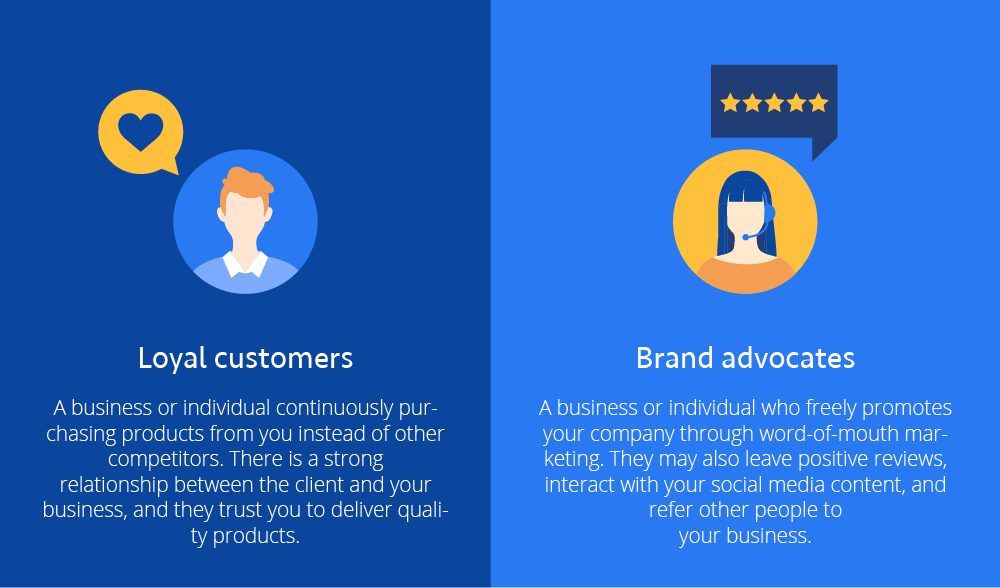Building Customer Loyalty and Brand Advocacy in B2B Through Customer Support


Dalia Arroyo
What is a benefit that comes from appreciating your customers? You get loyal customers and brand advocates. When you create loyal clients, you can increase revenue through word-of-mouth advertising while maintaining a low churn rate.
In this chapter, we will discuss:
- The importance of customer loyalty and brand advocacy
- Best practices to build customer loyalty
- How to create brand advocates
Offering an excellent customer care experience is one of the biggest factors when it comes to building brand advocates and customer loyalty. But why is it so important?

The Ultimate Guide to B2B Customer Service Strategy
Learn how to turn customers into brand advocates using our free customer service strategy guide.
The importance of customer loyalty and brand advocacy
Why should you encourage your customer support team to prioritize customer loyalty and brand advocacy? Both are important because they help increase sales revenue and customer lifetime value through repeat purchases, upsell and cross-sell opportunities, and free word-of-mouth advertising.
Here’s what these types of clients look like in practice:

Keep in mind that customer loyalty and brand advocacy go hand in hand. In order to gain an advocate, you need to first turn them into a loyal customer.
Building customer loyalty in B2B
Want to see an increase in revenue without the need to onboard more customers? Then train your customer service team to do all that they can to build customer loyalty.
A recent study conducted by Hubspot found that 93% of customers were more likely to be repeat customers for businesses that offered outstanding customer care. 73% of those clients were also more likely to share their experience with friends and review sites.
When you have dedicated users who will come to you first to buy certain solutions, it allows for you to cross-sell and upsell other products as well. It also gives you the confidence to know that your clients will prefer to have a long-term relationship.
In order to build customer loyalty, you should:
- Put the client first
- Prioritize product knowledge
- Connect with clients in real-time
- Provide customer self-service options
As you implement these methods into your customer service experience, you’ll begin to see an increase in customer loyalty and sales.
Put the client first
It’s your customer service reps’ duty to put the customer first by helping them and keeping them satisfied.
Putting the client first means doing all that you can to ensure your customer’s needs are being met.
There are several ways to put the customer first:
- Have a customer-first attitude: Your customer service reps should be friendly, positive, and happy to assist. So, you should look for reps with this demeanor as you hire and build out your team.
- Personalize the customer experience: Ensure your reps have access to your database that shares every detail about the client. This allows for them to know how to best address your customer’s needs.
- Base decisions around your client: Focus on making decisions based on the customer’s needs, not just around your bottom line. Ask yourself, “how will this benefit my clients?”
- Be transparent: Always keep your customers in the loop, even with issues the product may be facing or if you need more time resolving one of their concerns.
If your customer service team isn’t giving your clients the proper attention and support they deserve then you can expect them to walk out the door and take their business somewhere else. By putting the client first, your customers will feel seen and continue to choose your company.
Prioritize product knowledge
No matter who is on your customer service team, they need to have confidence assisting with your product by learning the ins and outs of it.
To ensure your customer service team is an expert on the product, we recommend holding training sessions to get your team familiar with the solution. You can also provide proper documentation through an internal knowledge base.
Then, when your customer comes to them with a simple question, your team will be ready to troubleshoot the issue.
Knowing your product builds trust between you and your customers. While your team has confidence in your solution, your client has confidence in receiving the right answers from you.
Connect with clients in real-time
Have you ever reached out to a business and you didn’t hear back from them for weeks, or even months? How likely were you to continue doing business with them?
Connecting with clients as soon as possible is an effective approach to building customer loyalty. When a member of your customer service department is working with a client in real-time, it builds a solid relationship between the two.
Be sure to keep wait times and hold times down for inbound inquiries. This can be achieved by having enough resources on your team, the right process, and tools.
Some ways you can reduce wait times is to:
- Improve how inquiries are routed through your queue
- Optimize your interactive voice response systems
- Ensure you have enough customer service reps, especially during busy times
Having a minimal wait time allows for you to be able to promptly work with your clients to resolve any issues they may have.
By working together in real-time, it turns a product issue into an “us vs. the problem” situation instead of a “client vs. business vs. problem” situation. Now instead of a negative experience using your company’s product, it turns into a positive experience working with your customer service team.
Customer self-service options
As your clients grow, you’ll want to provide options for your customers to help themselves. The best way to do this is by providing self-service options for your customers to find answers for themselves.
Self-service tools allow for your customers to find answers to their questions without the need to get a team member involved. This allows your customer service department more time to focus on bigger issues.
Here are some examples of self-service options:
- FAQ page
- Knowledge base
- Community forums
- Chatbots
By finding answers on their own, your clients will become self-sufficient with your product while still being pleased with the experience your business provides for them.
Now that you know how to promote customer loyalty, you can begin to turn your customers into advocates.
Creating a B2B brand advocacy strategy
When you provide an outstanding experience for your customers, they will be more than satisfied as a result. In turn, your clients will feel more compelled to share your company with fellow organizations. These brand advocates can generate a lot of new revenue for your company without you having to spend more on customer acquisition.
There are a variety of approaches your brand advocates, or champions, may take to build your brand awareness:
- Advertise through word of mouth
- Post reviews
- Share on social media
Each aspect of brand advocacy has the ability to reach a wider audience that will boost your company’s visibility. It also gives new prospects confidence in your product from the beginning since their colleagues gave it their stamp of approval.
But what can you do as a business to encourage your champions to spread the message about your brand?
Advertise through word of mouth
One of the most common ways customers advocate for you is through word-of-mouth advertising.
Your clients are frequently speaking with other people and businesses that you haven’t had a conversation with. So do all you can to ensure your company is enthusiastically being mentioned when they are speaking to these colleagues.
One of the best ways to do that is to have your customer service team provide support that goes the extra mile. A recent study done by Qualtrics found that 94% of American customers will recommend a company if they received excellent service.
Through word-of-mouth advertising, your champions will be spreading their knowledge on the effectiveness of your product.
Post reviews on B2B sites
Enabling customers to post reviews on trusted third-party sites — such as Clutch.co or G2 — allows your advocates to reach a wider audience than just their friends and associates.
As your champions share their experiences on review sites, your company will begin to earn credibility that prospects can trust. With enough positive reviews, prospective customers can turn to these review sites and come to the conclusion that your solution is right for them.
If you are providing an excellent product and exceptional service, sometimes all it takes is for you to invite your clients to share their reviews on these sites.
Here are a few tactics you can try to acquire a review:
- Include a link to the review site in your support emails or on the customer portal
- Mention the review sites when support reps speak to them on the phone
- Have your consultant directly ask for reviews from loyal customers
Each method can help generate the reviews you are looking for, but make sure you aren’t being forceful.
Share on social media
Similar to posting reviews, customers sharing and engaging with your company on social media casts a much larger net. Your brand advocates may have hundreds, if not thousands, of friends on their social media platforms that could become your prospective customers.
B2B social media platforms, like LinkedIn, allow your champions to promote your product in ways that countless people may see. As they like, comment, and share your content, their connections can learn more about your solution and how they can use it to their benefit.
One approach to get your customers to share your product on social media is by offering it to them at a discount or for free if they post about their time using it. Have them use the product and share a video or testimonial that explains their experience.
This allows their connections the opportunity to see your solution in action and can warm them up to purchasing it themselves.
Each strategy above can help you build brand advocacy, which allows you to gain new leads and prospects who are ready to learn more about your solution. The key is to make advocacy convenient for customers, present them with opportunities to vouch for you, and incentivize them when necessary.
Build customer loyalty and advocacy to reduce churn and increase revenue
By providing excellent customer support — such as putting the client first and connecting with them in real-time — you’ll be building devoted customers that will turn into brand advocates.
With the right strategy, these champions will then freely promote your brand. In turn, you will have ideal clients who generate more revenue and gain new leads.
Above all, don’t overlook the importance of an effective customer service strategy. From building a proper customer service team to retaining your existing clients, each element is a crucial instrument to your business.

The Ultimate Guide to B2B Customer Service Strategy
Learn how to turn customers into brand advocates using our free customer service strategy guide.

